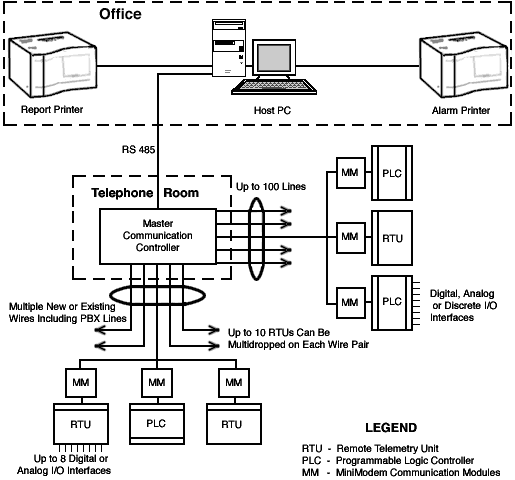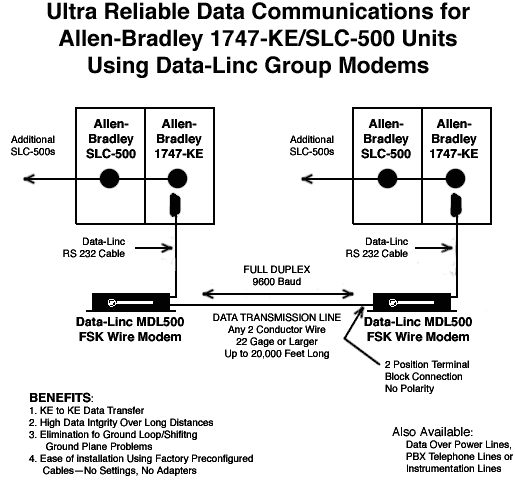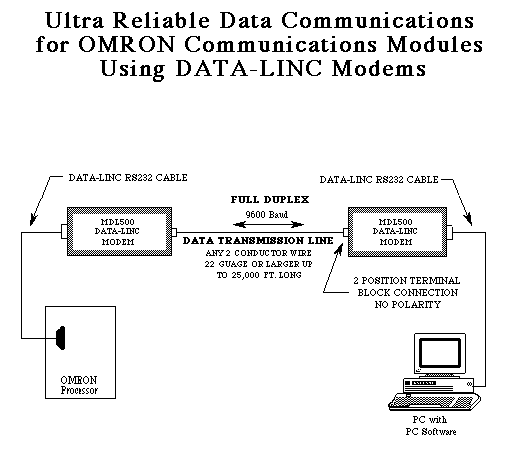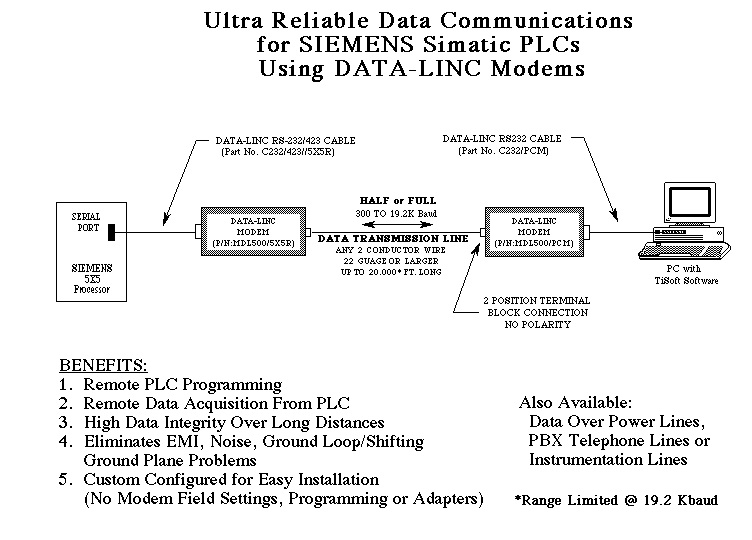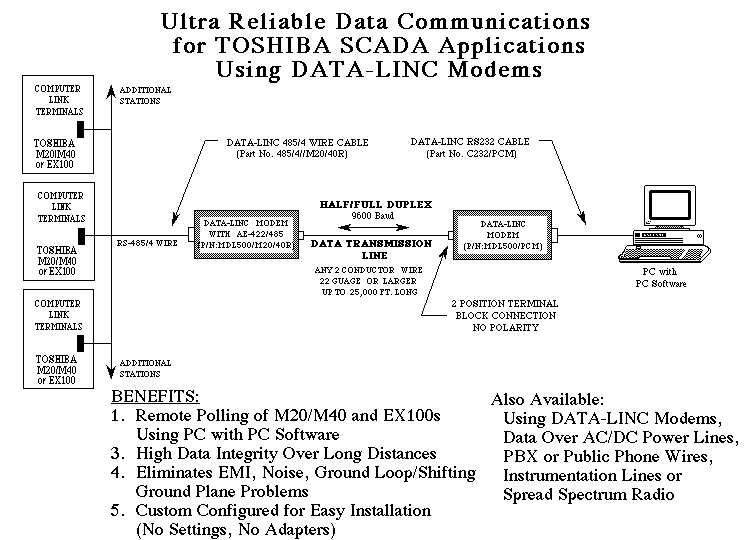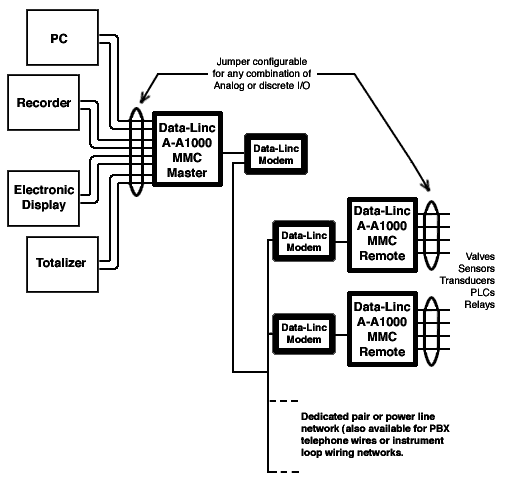|
|
||||
|
||||
|
|
Articles and Technical PapersThe FSK Advantage: New Techniques Support Enhanced Data Acquisition and ControlISA (July 1995) Authors:Michel E. Maes, President James R. Steffey, Vice President Data-Linc Group 2635 151st Place NE Redmond, Washington 98052 The United States of America Abstract Frequency Shift Key (FSK) signaling technology and signal conditioning provides significant advantages and benefits for economical and versatile distributed data acquisition and control requirements including communications accuracy, reliability and integrity in the transmission of digital, analog, discrete and pulse stream signals for monitoring and control applications. Principle benefits include: immunity to "adverse environment" conditions (i.e. electromagnetic interference, noise, surge, ground loop/ground plane shift problems); the ability to transmit data across commutators or sparking sources (sliding contacts, slip rings, rolling wheels, etc.): the transmission of any type of data over any two conductor wire, shielded or unshielded, twisted or untwisted, including existing in-place writing (up to 600 volt AC or DC power lines, PBX telephone wires, instrument loop wiring, etc.). Applications include polling, addressing, multi-drop and multiplexing installations. In summary, the FSK Advantage results in user-friendly ease of installation, operation and reconfiguration as well as significantly enhanced range, accuracy, reliability, and data integrity in hostile, harsh environments with the utmost in transparency (no software, protocol matching, baud rate settings, signal conditioning or PC required). Have you ever needed to monitor or control several channels of digital, discrete or analog I/O at some distance for the PLC, RTU or host computer and experienced either a) wiring problems, b) noise problems, or c) both? Connectivity challenges, including the escalating cost of wire installation, are becoming more troublesome as the complexity of data acquisition and control presents instrumentation engineers and technicians with technology overload headaches. As one harried engineer put it: "I just don't have the time to troubleshoot equipment breakdowns or data transmission interruptions>" Unfortunately, the complexity of today's digital technology has reached a point where it has become increasingly difficult to identify the problem let alone getting operations back on-line following a costly shutdown. An alternative is now available, however, in which advanced FSK technology can be applied to conditions requiring the utmost reliability and "user friendly" ease of installation, operation and reconfiguration, often at significantly lower cost. The technology supports data transmission for a wide variety of applications, such as process control, data acquisition, monitoring, energy management, access control, etc. Modular, portable units may be used for point-to-point, multi-drop, polling/addressing, multiplexing, of full LAN applications transmitting discrete, analog (4-20 mA, 0-5 volt, etc.), pulse stream or digital (RS232, 422, or 485) data. Applications for the technology include: Data communication between PLCs, RTUs and PCs; security system and access control monitoring; automated materials handling and warehousing (i.e. transmitting data from control computers to stacker cranes over the AC/DC lines supplying such devices, across the sliding contacts); remote display in driver/electronic sign control; mine safety data gathering; waste water treatment remote monitoring/control tasks; and multi-station process control/monitoring including SCADA. In summary, the principal features and benefits include:
In Summary, the ability to move any data (digital, analog, discrete or pulse stream) on any two conductor already existing or installed wiring can result in substantial saving over the expense of traditional cable installation, particularly for difficult applications or in hostile environments. The FSK Advantage Currently, the vast majority of data transmitted in industrial/commercial monitoring and control applications is in digital form, typically either RS-232, 422 or 485, except where extensive ISDN type installations involving Computer Integrated Manufacturing (CIM) networks are required. Nevertheless, much of the equipment is often analog in which A/D and D/A conversions and instrument loop wire installations are a typical necessary expense in moving the data from where it originates to where it is needed. Analog to digital conversion for the sole purpose of data transmission to other locations (where additional D/A converters must be installed if sensor outputs are being sent, for example, to analog recorders or totalizers) can prove to be more expensive and less reliable than the now available advanced "modem" devices providing a number of distinct advantages as itemized in the Introduction. The FSK Advantage is based upon the ability to convert ASCII data streams, or any other digitally encoded information, into frequency equivalents prior to transmission from point-to-point. Digital information is coded in a series of 1s and 0s (high and low or space and mark) which are represented by two voltage levels. It travels between electronic devices such as computers or PLCs as a flow of logic signals that shift back and forth between the two voltage levels. If electrical noise, changing ground voltage or signal attenuation generates a "threshold" level difference between the two voltages, data error can result. An FSK "MODEM" converts the data stream from changing voltage levels to changing frequencies. One frequency is assigned to the "1" and another to the "0". The FSK transmitter converts digital signals to frequency (Modulation) and the receiver converts it back to digital form (DEModulation). With FSK, data is not transmitted as a series of voltage step changes, but instead as two alternating frequencies. Data communications problems are dealt with effectively because of this unique characteristic of the FSK signal. Clearly, electromagnetic interference, shifting ground planes, ground loops and long transmission distances all create problems that compromise data integrity. FSK is a communication technology largely immune to such problems also providing exceptional flexibility in the selection of a communication path.
Industrial data acquisition and process control challenges in high value-added operations are such that equipment reliability and dependability are essential in preventing costly down time incidents. In this digital era, equipment malfunctions can result in extensive and lengthy troubleshooting efforts before a problem can be detected and corrected. Too often, the inability to rapidly identify data transmission reliability as the culprit can significantly compromise product quality or delay resumption of operations. The care taken, therefore, in the selection of computer hardware, software and peripheral equipment such as PLCs or RTUs should also be applied to the recognition that data communications between devices is every bit as critical, not only in controlling installation costs, but also toward insuring efficient, reliable on-going operations. The ultimate objective of any data communication device is to provide error free data. A further practical objective is trouble free operation and ease of installation. The inherent characteristics of FSK technology allow these objectives to be achieved in many instances when straight digital communications is potentially marginal or unreliable. A properly designed FSK modem can not only be "plug and play" but also deliver on-going maintenance free service. FSK sidesteps most basic communications problems and its versatility results in many innovative data communications solutions. Comprehensive Monitoring and Control SystemThe Comprehensive Monitoring and Control System (CMCS) illustrates how the technology may be applied in a typical installation, superimposing discrete, digital and analog data on the in-place facility PBX wiring for remote data acquisition and control between a host computer, PLCs and RTUs. As more and more data are transmitted with increasingly complex SCADA type systems, requirements are proliferating not only for monitoring and control functions, but for additional data as well such as access control, energy management, etc. Installation of independent datacom systems to deal with these requirements results in cumbersome, expensive and difficult to maintain wiring networks subject to on-going periodic interruptions or degraded performance, too often even involving undetected error. The CMCS illustrates how significant cost, reliability and other advantages may be obtained with application of the FSK advantage to large-scale distributed monitoring and control tasks. A typical installation is shown herein. |
|||
Typical Installation
Interfacing FSK Modems With PLC Processor EquipmentAdvanced technology FSK Modems may be used to significantly enhance the accuracy, reliability and data integrity of PLC Processor equipment in the transmission of data between separate locations. Whereas the PLC Processor companies expend considerable effort to optimize their equipment for bulletproof reliability, accuracy and data integrity, the requirement to transmit data from point to point imposes real-world limitations and problems. Typical industrial adverse environment conditions such as noise, surge, and electromagnetic interference as well as ground loop/shifting ground plane problems are often encountered. Range limitations may also arise. Modems employing The FSK Advantage support the transmission of data, on any two-conductor wire, to and from virtually all PLC Processors. User-friendly ease of installation results from the well-deserved reputation for simple plug and play connections that is the hallmark of FSK technology.Selected Typical Examples
|
|
| ^ Top of Page ^ | ||
|
|
||
| Products |
Features & Benefits | Focus Item | Product Selection Guides | Catalog | PDF Library | Order Information | |
| Tech Resources |
Engineering Specifications | Articles & Technical Papers | Installation Information | |
| Partners |
GE Fanuc | Omron | Rockwell Automation | Schneider Electric | Siemens | Technology Partners | |
| Industries |
Security | Traffic | and other industry application notes and diagrams | |
| Sales Channels |
Distributors | System Integrators | OEMs | |
| News |
Tradeshows and Events | Press Releases | Newsletters | |
| About Us |
Overview | Jobs/Employment | Office Locations/Contact Information | |
|
|
||
| © 1996-2015 Data-Linc Group. All rights reserved. | ||
| 071025 |





